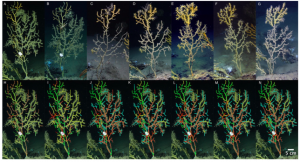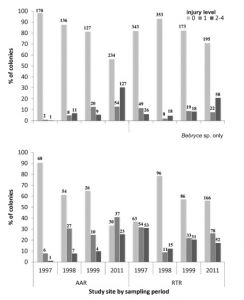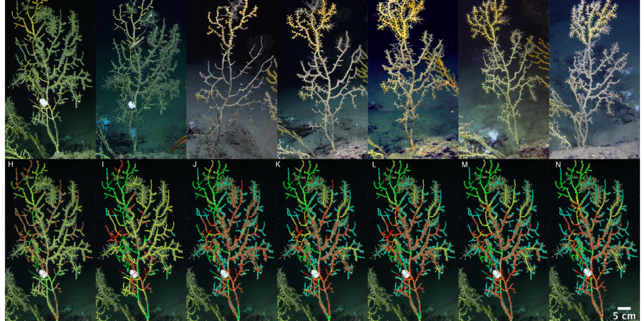Long-term effects on long-lived ecosystems: oil spills and deep-water corals
By: Molly Rickles, SRC Intern
The Deepwater Horizon Oil Spill occurred in 2010 in the Gulf of Mexico and was one of the largest oil spills ever recorded. During the 85 days before the spill was capped, over 4.9 million barrels of oil were released. The Deepwater Horizon Oil Spill was unique because most spills occur at the surface, but this particular oil spill occurred at 1500 meter below sea level. The spill occurred at the Macondo Prospect well, which is located about 41 miles off the southeast coast of Louisiana. To clean up the oil, 7 million liters of dispersant was applied at the surface. This chemical compound was used to absorb the oil and stop it’s spreading. However, dispersant is known for being extremely damaging to marine life. This mixture of oil and dispersant was especially damaging to corals. In addition, dispersant can stay in the water for up to four years, making it extremely long lived (Frometa et al. 2017). While the chemical is efficient at cleaning oil on the surface of the water, it is very detrimental to the marine environment as a whole.
In the Gulf of Mexico, there are over 258 species of corals, making it a very diverse marine environment (Girard & Fisher, 2018). Corals are slow growing and long lived, which makes them extremely susceptible to anthropogenic stresses. This was a major concern following the spill, since there was very little baseline information on the deep-water ecosystems in the Gulf of Mexico. These deep-water reef tracts are located at depths around 1500 meters and host a variety of species, including octocorals, sponges and hermatypic corals (Silva, Etnoyer, Macdonald, 2016). The largest reef tract that was located near the oil spill is the Pinnacle Track Reef. This reef has remnants of shallow water reef that formed before sea level rise, and now hosts a variety of deep-water organisms (Frometa et al. 2017).

Figure 1: This image shows the changes in an impacted coral colony between 2011 and 2017. Healthy coral is shown in green, unhealthy coral is shown in red, colonized by hydroids is shown in yellow and purple shows unclassified coral. Girard, F., & Fisher, C. R. (2018). Long-term impact of the Deepwater Horizon oil spill on deep-sea corals detected after seven years of monitoring. Biological Conservation,225, 117-127. doi:10.1016/j.biocon.2018.06.028
Several studies began looking at deep-water reef tracks after the oil spill. There were a few studies that already had images of the reef track prior to the spill, so this was used as baseline data. After the spill, researchers took images of the reef at varying intervals for up to seven years following the spill. After the initial dispersal of oil, the reef was covered in a mixture of oil and dispersant. Most of the oil that was released from the well remained at depth, which created a plume that existed for months. In addition, oil-contaminated marine snow fell onto the reefs from the surface, which caused additional damage (Girard & Fisher, 2018). It was found that the most common type of injury was the accumulation of biofilm on the corals (Silva, Etnover, Macdonald, 2016). Other injuries included bare skeletons, broken or missing branches, overgrowth of hydroids and necrosis. In addition, taller corals displayed higher rates of injuries. The initial level of impact from the oil spill caused less healthy branches, and breakage occurred very frequently at impacted sites (Girard & Fisher, 2018). Another interesting finding was that the initial level of total visible impact was correlated to recovery time, meaning that reefs that were highly impacted by the initial oil spill were less likely to fully recover (Girard & Fisher, 2018).
While almost all deep-water reefs showed damaged from the spill, there were a few located far enough away in the Gulf of Mexico that were used as reference sites. It was determined that these reference sites were significantly less damaged than affected sites, meaning that the oil spill caused injury and damage to the deep-water reefs. These effects were magnified by the occurrence of Tropical Storm Bonnie, which occurred two months following the spill. It has been hypothesized that the tropical storm accelerated the mixing of water and oil, leading to more oil being dispersed along deep-water reef tracks (Silva et al. 2016).

Figure 2: This graph shows injury level varying by years for two reef tracks. Before the spill, the injury level was commonly zero for most of the observed sites. After 2011, the injury level is significantly higher, and the number of reefs with no injuries declines drastically. Silva, M., Etnoyer, P. J., & Macdonald, I. R. (2016). Coral injuries observed at Mesophotic Reefs after the Deepwater Horizon oil discharge. Deep Sea Research Part II: Topical Studies in Oceanography,129, 96-107. doi:10.1016/j.dsr2.2015.05.013
The Deepwater Horizon Oil Spill was an extremely damaging event to the Gulf of Mexico, and its effects are still ongoing. While many scientists focused on the visible effects of the spill such as the impact on birds, marine mammals and beaches, the majority of the effects occurred in deep-water. Since the deep-water reef tracts are the source of much of the Gulf of Mexico’s diversity, it is extremely important to study the effects of the spill on these areas. Since there was very little baseline data on these reefs before the spill, it is necessary to establish a baseline data set of these reef tracts so damage can be more easily assessed in the future.
Work Cited:
Frometa, J., Delorenzo, M. E., Pisarski, E. C., & Etnoyer, P. J. (2017). Toxicity of oil and dispersant on the deep water gorgonian octocoral Swiftia exserta, with implications for the effects of the Deepwater Horizon oil spill. Marine Pollution Bulletin,122(1-2), 91-99. doi:10.1016/j.marpolbul.2017.06.009
Girard, F., & Fisher, C. R. (2018). Long-term impact of the Deepwater Horizon oil spill on deep-sea corals detected after seven years of monitoring. Biological Conservation,225, 117-127. doi:10.1016/j.biocon.2018.06.028
Silva, M., Etnoyer, P. J., & Macdonald, I. R. (2016). Coral injuries observed at Mesophotic Reefs after the Deepwater Horizon oil discharge. Deep Sea Research Part II: Topical Studies in Oceanography,129, 96-107. doi:10.1016/j.dsr2.2015.05.013



